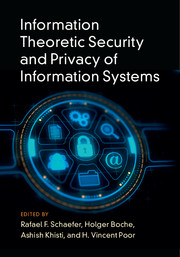Book contents
- Frontmatter
- Contents
- List of Contributors
- Preface
- Part I Theoretical Foundations
- Part II Secure Communication
- Part III Secret Key Generation and Authentication
- 12 Multiple Secret Key Generation: Information Theoretic Models and Key Capacity Regions
- 13 Secret Key Generation for Physical Unclonable Functions
- 14 Wireless Physical-Layer Authentication for the Internet of Things
- Part IV Data Systems and Related Applications
- Index
- References
13 - Secret Key Generation for Physical Unclonable Functions
from Part III - Secret Key Generation and Authentication
Published online by Cambridge University Press: 28 June 2017
- Frontmatter
- Contents
- List of Contributors
- Preface
- Part I Theoretical Foundations
- Part II Secure Communication
- Part III Secret Key Generation and Authentication
- 12 Multiple Secret Key Generation: Information Theoretic Models and Key Capacity Regions
- 13 Secret Key Generation for Physical Unclonable Functions
- 14 Wireless Physical-Layer Authentication for the Internet of Things
- Part IV Data Systems and Related Applications
- Index
- References
Summary
Secure storage of cryptographic keys is a popular application for responses generated from physical unclonable functions (PUFs). It is, however, required to correct these noisy PUF responses in order to derive the same key under all environmental conditions. This is enabled by mapping the random response pattern of the PUF to codewords of error correcting codes using so called helper data, and by proper error correction mechanisms.
This chapter maps the process of key storage with PUFs to the information theoretic model of key agreement from a compound source and shows theoretical bounds. It introduces a unified algebraic description of helper data generation schemes that is able to represent most state-of-the-art approaches. This is used together with the theoretic bounds to analyze the existing schemes. The focus here is secrecy leakage through the helper data. The new representation will allow the analysis of future schemes in an early design phase.
Introduction
Physical circuit properties such as exact run times vary for each manufactured chip. The root cause for this phenomenon is slight variations in process parameters that affect, e.g., the threshold voltages and electron mobility in the transistors of the circuit. To ensure predictable and reliable behavior of circuits, much effort is spent to mitigate the effect of such unpredictable variations. However, they turn out to be unavoidable and, moreover, the influence of these variations on the circuit properties increases with decreasing process sizes. While conventional circuits suffer from this fact, silicon-based physical unclonable functions take advantage of the variations: they capture randomness in the manufacturing process and transform the analog physical variations into digital numbers that can be interpreted as the outcome of a random variable. Then, the quantized result can be used for authentication in a challenge–response protocol or to embed a key into a device and only reproduce it on demand to avoid permanent storage of secret keys in non-volatile memory.
Since silicon PUFs are constructed from transistors, other standard devices, or even from standard cells, their implementation fits in seamlessly with the standard digital design flow and manufacturing process. Therefore, PUFs can be easily added to a standard integrated circuit and bridge the gap between the increasing demand for security and the restriction of a low additional cost overhead. Furthermore, PUFs can still be built in deep sub-micron technologies where standard solutions for secure key storage, e.g., secured non-volatile memory, are no longer available.
- Type
- Chapter
- Information
- Publisher: Cambridge University PressPrint publication year: 2017
References
- 7
- Cited by



